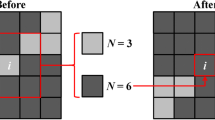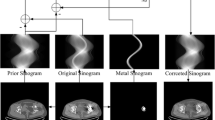Abstract
The reduction of metal artifacts remains a challenge in computed tomography because they decrease image quality, and consequently might affect the medical diagnosis. The objective of this study is to present a novel method to correct metal artifacts based solely on the CT-slices. The proposed method consists of four steps. First, metal implants in the original CT-slice are segmented using an entropy based method, producing a metal image. Second, a prior image is acquired using three transformations: Gaussian filter, Parisotto and Schoenlieb inpainting method with the Mumford-Shah image model and L0 Gradient Minimization method (L0GM). Next, based on the projections from the original CT-slice, prior image and metal image, the sinogram is corrected in the traces affected by metal in the process called normalization and denormalization. Finally, the reconstructed image is obtained by FBP and a Nonlocal Means (NLM) filtering. The efficacy of the algorithm is evaluated by comparing five image quality metrics of the images and by inspecting regions of interest (ROI). Phantom data as well as clinical datasets are included. The proposed method is compared with three established metal artifact reduction (MAR) methods. The results from a phantom and clinical dataset show the visible reduction of artifacts. The conclusion is that IMIF-MAR method can reduce streak metal artifacts effectively and avoid new artifacts around metal implants, while preserving the anatomical structures. Considering both clinical and phantom studies, the proposed MAR algorithm improves the quality of clinical images affected by metal artifacts, and could be integrated in clinical setting.










Similar content being viewed by others
References
Gjesteby L, Man BD, Jin Y et al (2016) Metal artifact reduction in CT: where are we after four decades? IEEE Access 4:5826–5849. https://doi.org/10.1109/ACCESS.2016.2608621
Guggenberger R, Winklhofer S, Osterhoff G et al (2017) Metallic artefact reduction with monoenergetic dual-energy CT: systematic ex vivo evaluation of posterior spinal fusion implants from various vendors and different spine levels. Eur Radiol 22:2357–2364. https://doi.org/10.1007/s00330-012-2501-7
Ohira S, Kanayama N, Wada K et al (2018) How well does dual-energy computed tomography with metal artifact reduction software improve image quality and quantify computed tomography number and iodine concentration? JCAT 42:655–660. https://doi.org/10.1097/RCT.0000000000000735
Bismark R, Frysch R, Rose G (2016) Reduction of beam hardening artifacts on real C-Arm CT data using statistical polyenergetic image reconstruction. In: 4th International Conference on Image Formation in X-Ray Computed Tomography. Germany
Abdurahman S, Frysch R, Bismark R et al (2018) Beam hardening correction using cone beam consistency conditions. IEEE Trans Med Imaging 37:2266–2277. https://doi.org/10.1109/TMI.2018.2840343
Glover GH, Pelc NJ (1981) An algorithm for the reduction of metal clip artifacts in CT reconstructions. Med Phys 8:799–807. https://doi.org/10.1118/1.595032
Mahnken AH, Raupach R, Wildberger JE et al (2003) A new algorithm for metal artifact reduction in computed tomography: in vitro and in vivo evaluation after total hip replacement. Invest Radiol 38:769–775. https://doi.org/10.1097/01.rli.0000086495.96457.54
Yazdia M, Gingras L, Beaulieu L (2005) An adaptive approach to metal artifact reduction in helical computed tomography for radiation therapy treatment planning: experimental and clinical studies. Int J Radiat Oncol Biol Phys 62:1224–1231
Wei J, Chen L, Sandison GA et al (2004) X-ray CT high-density artefact suppression in the presence of bones. Phys Med Biol 49:5407. https://doi.org/10.1088/0031-9155/49/24/001
Mehranian A, Ay MR, Rahmim A, Zaidi H (2013) X-ray CT metal artifact reduction using wavelet domain sparse regularization. IEEE Trans Med Imaging 32:1707–1722
Zhao S, Robeltson DD, Wang G et al (2000) X-ray CT metal artifact reduction using wavelets: an application for imaging total hip prostheses. IEEE Trans Med Imaging 19:1238–1247
Kalender WA, Hebel R, Ebersberger J (1987) Reduction of CT artifacts caused by metallic implants. Radiol 164:576–577. https://doi.org/10.1148/radiology.164.2.3602406
Yu H, Zeng K, Bharkhada DK et al (2007) A segmentation-based method for metal artifact reduction. Acad Radiol 14:495–504. https://doi.org/10.1016/j.acra.2006.12.015
Hahn K, Schöndube H, Stierstorfer K et al (2016) A comparison of linear interpolation models for iterative CT reconstruction. Med Phys 43:6455–6473. https://doi.org/10.1118/1.4966134
Meyer E, Raupach R, Lell M et al (2010) Normalized metal artifact reduction (NMAR) in computed tomography. Med Phys 37:5482–5493. https://doi.org/10.1118/1.3484090
Meyer E, Raupach R, Lell M et al (2012) Frequency split metal artifact reduction (FSMAR) in computed tomography. Med Phys 39:1904–1916. https://doi.org/10.1118/1.3691902
Meyer E, Raupach R, Schmidt B, et al (2011) Adaptive normalized metal artifact reduction (ANMAR) in computed tomography. In: 2011 IEEE Nuclear Science Symposium Conference Record. pp 2560–2565
Prell D, Kalender WA, Kyriakou Y (2010) Development, implementation and evaluation of a dedicated metal artefact reduction method for interventional flat-detector CT. Br J Radiol 83:1052–1062. https://doi.org/10.1259/bjr/19113084
Prell D, Kyriakou Y, Struffert T et al (2010) Metal artifact reduction for clipping and coiling in interventional C-arm CT. AJNR Am J Neuroradiol 31:634–639. https://doi.org/10.3174/ajnr.A1883
Hung SC, Wu CC, Lin CJ, Guo WY, Luo CB, Chang FC, Chang CY (2014) Artifact reduction of different metallic implants in flat detector C-arm CT. AJNR Am J Neuroradiol 35:1288–1292. https://doi.org/10.3174/ajnr.A3851
Chen Y, Li Y, Guo H, Hu Y, Luo L, Yin X, Gu J, Toumoulin C (2012) CT metal artifact reduction method based on improved image segmentation and sinogram in-painting. Math Probl Eng. https://doi.org/10.1155/2012/786281
Peng C, Qiu B, Li M et al (2017) Gaussian diffusion sinogram inpainting for X-ray CT metal artifact reduction. BioMed Eng OnLine. https://doi.org/10.1186/s12938-016-0292-9
Wang G, Snyder DL, O’Sullivan JA, Vannier MW (1996) Iterative deblurring for CT metal artifact reduction. IEEE Trans Med Imaging 15:657–664
Zhang H, Wang L, Li L et al (2016) Iterative metal artifact reduction for x-ray computed tomography using unmatched projector/backprojector pairs. Med Phys 43:3019–3033. https://doi.org/10.1118/1.4950722
Lemmens C, Faul D, Nuyts J (2009) Suppression of metal artifacts in ct using a reconstruction procedure that combines map and projection completion. IEEE Trans Med Imaging 28:250–260. https://doi.org/10.1109/TMI.2008.929103
Zeng GL (2017) A fast method to emulate an iterative POCS image reconstruction algorithm. Med Phys 44:e353–e359. https://doi.org/10.1002/mp.12169
Geyer LL, Schoepf UJ, Meinel FG et al (2015) State of the art: iterative CT reconstruction techniques. Radiology 276:339–357. https://doi.org/10.1148/radiol.2015132766
Claus BE, Jin Y, Gjesteby LA, et al (2017) Metal-artifact reduction using deep-learning based Sinogram completion: Initial results. In: Proceedings of the 14th International Meeting Fully Three-Dimensional Image Reconstruction Radiology and Nuclear Medicine. China, pp 631–634
Zhang Y, Yu H (2018) Convolutional neural network based metal artifact reduction in x-ray computed tomography. IEEE Trans Med Imaging 37:1370–1381. https://doi.org/10.1109/TMI.2018.2823083
Naranjo V, Lloréns R, Alcañiz M, López-Mir F (2011) Metal artifact reduction in dental CT images using polar mathematical morphology. Comput Methods Programs Biomed 102:64–74. https://doi.org/10.1016/j.cmpb.2010.11.009
Bal M, Celik H, Subramanyan K, et al (2005) A radial adaptive filter for metal artifact reduction. In: Medical Imaging 2005: Image Processing. pp 2075–2082
Rodríguez-Gallo Y, Orozco-Morales R, Pérez-Díaz M (2018) Metal artifact reduction by morphological image filtering for computed tomography. World Congress on Medical Physics and Biomedical Engineering 2018. Springer, Prague, pp 219–222
Watzke O, Kalender WA (2004) A pragmatic approach to metal artifact reduction in CT: merging of metal artifact reduced images. Eur Radiol 14:849–856
Ballhausen H, Reiner M, Ganswindt U et al (2014) Post-processing sets of tilted CT volumes as a method for metal artifact reduction. Radiat Oncol 9:114. https://doi.org/10.1186/1748-717X-9-114
Rodriguez-Gallo Y, Orozco-Morales R, Perez-Diaz M (2019) Gradient image smoothing for metal artifact reduction (GISMAR) in computed tomography. Biomed Phys Eng Express. https://doi.org/10.1088/2057-1976/ab0c4d
Schönlieb C-B (2015) Partial differential equation methods for image inpainting. Cambridge University Press, Cambridge
Parisotto S, Schoenlieb C-B (2016) MATLAB codes for the image inpainting problem. Cambridge University, Cambridge
Xu L, Lu C, Xu Y, Jia J (2011) Image smoothing via L0 gradient minimization. ACM Trans Graph 30:174:1-174:12. https://doi.org/10.1145/2070781.2024208
He Y, Jie L, Dehong Y, Pu W (2014) An improved algorithm of the maximum entropy image segmentation. In: 2014 Fifth International Conference on Intelligent Systems Design and Engineering Applications. pp 157–160
Li Z, Leng S, Yu L et al (2017) An effective noise reduction method for multi-energy CT images that exploits spatio-spectral features. Med Phys 44:1610–1623. https://doi.org/10.1002/mp.12174
Lell MM, Meyer E, Schmid M et al (2013) Frequency split metal artefact reduction in pelvic computed tomography. Eur Radiol 23:2137–2145. https://doi.org/10.1007/s00330-013-2809-y
Liu X, Mei W, Du H (2016) Multimodality medical image fusion algorithm based on gradient minimization smoothing filter and pulse coupled neural network. Biomed Signal Process Control 30:140–148. https://doi.org/10.1016/j.bspc.2016.06.013
Duan Y, Chang H, Huang W et al (2015) The L0 regularized mumford-shah model for bias correction and segmentation of medical images. IEEE Trans Image Process 24:3927–3938. https://doi.org/10.1109/TIP.2015.2451957
Tristán-Vega A, García-Pérez V, Aja-Fernández S, Westin C-F (2012) Efficient and robust nonlocal means denoising of MR data based on salient features matching. Comput Methods Programs Biomed 105:131–144. https://doi.org/10.1016/j.cmpb.2011.07.014
Gu K, Liu M, Zhai G et al (2015) Quality assessment considering viewing distance and image resolution. IEEE T BROADCAST 61:520–531. https://doi.org/10.1109/TBC.2015.2459851
Wang Z, Li Q (2011) Information content weighting for perceptual image quality assessment. IEEE Trans Image Process 20:1185–1198
Wang Z, Simoncelli EP, Bovik AC (2003) Multiscale structural similarity for image quality assessment. In: The Thrity-Seventh Asilomar Conference on Signals, Systems Computers, 2003. pp 1398–1402 Vol.2
Xue W, Zhang L, Mou X, Bovik AC (2014) Gradient magnitude similarity deviation: a highly efficient perceptual image quality index. IEEE Trans Image Process 23:684–695. https://doi.org/10.1109/TIP.2013.2293423
Acknowledgements
The authors gratefully acknowledge funding by the Deutscher Akademischer Austauschdienst (DAAD) as well as funding by the Federal Ministry of Education and Research within the Forschungscampus STIMULATE under grant number '13GW0095A'. We thank Professor Georg Rose for his support and guidance. Also, thanks to Vojtech Kulvait, Robert Frysch, Cindy Lübeck for their assistance in imaging experiments, and Dr. Oliver Beuing from the University Hospital Magdeburg for his collaboration.
Funding
This paper was done by funding the Deutscher Akademischer Austauschdienst (DAAD) as well as funding by the Federal Ministry of Education and Research within the Forschungscampus STIMULATE under Grant Number '13GW0095A'.
Author information
Authors and Affiliations
Corresponding author
Ethics declarations
Conflict of interest
The authors declare that they have no conflict of interest.
Ethical approval
The code was programmed in Matlab R 2018 b and it will be sent to the Journal if necessary All procedures performed in studies involving human participants were in accordance with the ethical standards of the institutional and/or national research committee and with the 1964 Helsinki declaration and its later amendments or comparable ethical standards. Part of the data was previously used in Magdeburg University and it was donated for our work. The patient data acquired by us and used in a previous article, was approved by the Ethics Committee: "Cardiocentro de Villa Clara". Approval number 12/2017.
Informed consent
Informed consent was previously obtained from individual participants included in the study. Images 6, 7, 8, 9 and 10 were properly anonymized for publication purposes. There are not details in the work that reveal the identity of the patients. Patient consent for publication, is not applicable.
All authors have actively contributed to this article through data collection, development of experiments, analysis of results and writing the article.
Additional information
Publisher's Note
Springer Nature remains neutral with regard to jurisdictional claims in published maps and institutional affiliations.
Rights and permissions
About this article
Cite this article
Rodríguez-Gallo, Y., Orozco-Morales, R. & Pérez-Díaz, M. Inpainting-filtering for metal artifact reduction (IMIF-MAR) in computed tomography. Phys Eng Sci Med 44, 409–423 (2021). https://doi.org/10.1007/s13246-021-00990-8
Received:
Accepted:
Published:
Issue Date:
DOI: https://doi.org/10.1007/s13246-021-00990-8




